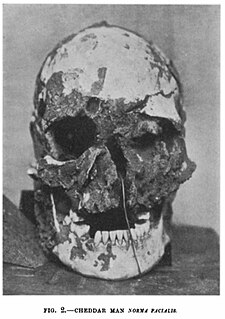 W
WCheddar Man is a human male fossil found in Gough's Cave in Cheddar Gorge, Somerset, England. The skeletal remains date to the Mesolithic and it appears that he died a violent death. A large crater-like lesion just above the skull's right orbit suggests that the man may have also been suffering from a bone infection.
 W
WThe Dagenham idol is a wooden statue of a naked human figure, found in Dagenham in 1922. The statue has been carbon dated to around 2250 BC, during the late Neolithic period or early Bronze Age, making it one of the oldest human representations found in Europe.
 W
WThe Havering hoard is a hoard of 453 late Bronze-age artefacts found at a site overlooking the River Thames in Rainham, London, in 2018. It is the largest bronze-age hoard to be found in London and the third-largest in the United Kingdom. The discovery was made during an archaeological investigation of the site prior to its use for gravel extraction. The finds included weapons, tools and ingots, but only a small quantity of jewellery. It was unusual in being buried in four separate locations; most bronze-age hoards previously excavated have been concentrated in a single location. Some of the items have been identified as of continental European origin, demonstrating links with that region. Several proposals have been put forward for the origin of the hoard, which include a collection of goods for recycling, an attempt by a single individual to control the bronze trade in the area or the large-scale abandonment of bronze goods at the start of the Iron Age. The artefacts are currently on exhibition at the Museum of London Docklands, after which they will be on display at the Havering Museum.
 W
WIn archeology, a hut circle is a circular or oval depression in the ground with evidence of a low stone wall around it that used to be the foundation of a round house. The superstructure of such a house would have been made of timber and thatch. They are numerous in parts of upland Britain and most date to around the 2nd century BC.
 W
WThe prehistory of the County of Norfolk, England is broken into specific time periods.
 W
WThe Red Lady of Paviland is an Upper Paleolithic partial skeleton of a male dyed in red ochre and buried in Britain 33,000 BP. The bones were discovered in 1823 by William Buckland in an archaeological dig at Goat's Hole Cave — one of the limestone caves between Port Eynon and Rhossili on the Gower Peninsula, south Wales.
 W
WThe Swastika Stone is a stone adorned with a design that resembles a swastika, located on the Woodhouse Crag on the northern edge of Ilkley Moor in West Yorkshire. The design has a double outline with five curved arms enclosing several so-called 'cup' marks, the like of which can be found on other stones nearby.